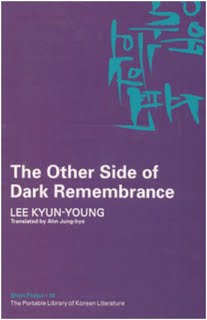 The KTLIT Wikipedia Project has put another author up. It is Lee Kyun-young. The page is here, and it looks something like this:
The KTLIT Wikipedia Project has put another author up. It is Lee Kyun-young. The page is here, and it looks something like this:
Lee Kyun-young
| Lee Kyun-young | |
|---|---|
| Born | December 30, 1951(1951-12-30) |
| Died | November 10, 1996(1996-11-10) (aged 44) |
| Occupation | Novelist |
| Nationality | South Korea |
| Period | 1951-1996 |
| Genres | Modern Korean Fiction |
| Notable work(s) | The Other Side of Dark Remembrance |
- This is a Korean name; the family name is Lee.
Lee Kyun-young (born 1951) (Hangul: 이) is a South Korean writer.
Life
Lee Kyun-young was born in 1951 in Jeollanam-do Province. He graduated from Hanyang University and later worked as a Professor of Korean History at Dongduk Women’s University.[1] Lee won the Yi Sang Literature Prize, awarded by the Dong-A Ilbo, in 1984.[2] His important works include a collection of stories titled The Faraway Light (1986) and the novel The Country of Lao-Tzu and Chuang-Tzu. Sadly, in 1996 Lee died in a car crash. In English, his most famous work is The Other Side of Dark Remembrance, which was originally published in 1979 as a shorer story titled Division.
From 1986 until his early death , Lee was an editor of Historical Criticism published by Research Institute for Historical Problems. Lee primarily focused on the Korean independence movement. His work on Singanhoe, an independence group, which culminated in Study of Singanhoe (Singanhoe yeongu, 1993), earned Lee the 8th Danjae Scholarsic Award. Study of Singanhoe is considered to be the first research text that provides an unbiased view of Singanhoe. In 1993, he published a full-length novel The Country of Laozi and Zhuangzi (Nojawa jangjaui nara). Another novel The Leaves Make Lights of Longing (Namunipdeureun grieun bulbiteul mandeunda), appeared in the 1997 Spring issue of World Literature, after Lee’s death. Other works include the children’s books, Scary Dance (Museo-un chum, 1986) and The Color of Winter Dream (Gyeoul kkumui saeksang, 1986) as well as a research work titled, Patriotic Enlightenment Movement During the Period of Daehanjeguk (Hanmal aeguk gyemong undong, 1991). [3]
Lee’s fiction has three distinctive aspects. First, his subjects and themes often focus on people who have been dispossessed and are wandering. Second the stories tend to have an autobiographical style – that is they are the life story of one man or a family. Finally, like many writers of the era, Lee’s stories have a profound awareness of the painful history of Korea.[4]
Work
Works in English
The Other Side of Dark Remembrance
Works in Korean (partial)
- Academic
Study of Singanhoe (Singanhoe yeongu, 1993)
Patriotic Enlightenment Movement During the Period of Daehanjeguk (Hanmal aeguk gyemong undong, 1991)]
- Novels
The Country of Laozi and Zhuangzi (Nojawa jangjaui nara)
The Leaves Make Lights of Longing (Namunipdeureun grieun bulbiteul mandeunda)
- Children’s books, Scary Dance (Museo-un chum, 1986)
The Color of Winter Dream (Gyeoul kkumui saeksang, 1986)
- Short story collections
The Faraway Light (1986)


